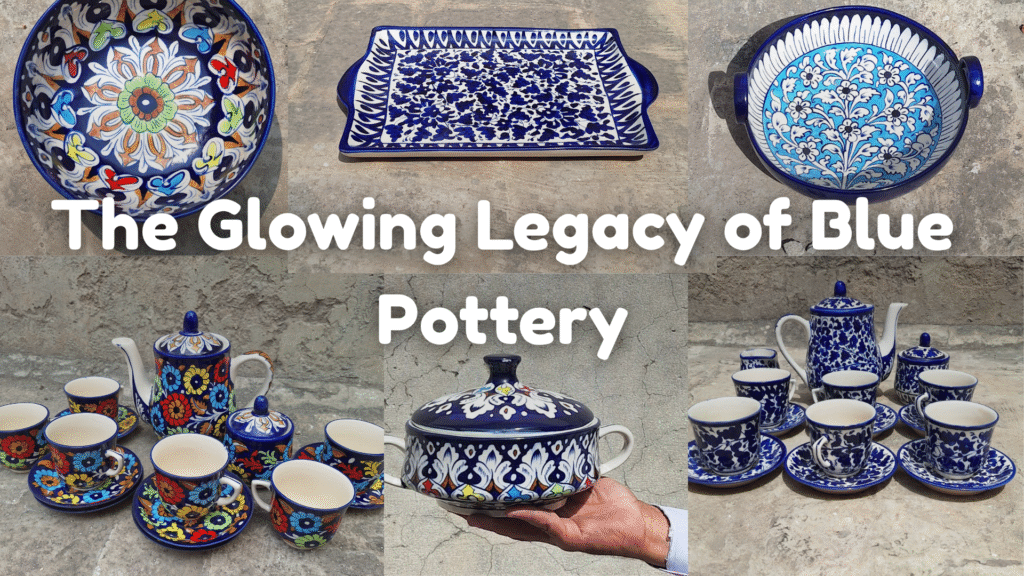
Why Blue Pottery Still Captivates the World
Imagine walking through a centuries-old shrine in Multan, Pakistan. The sun hits the glazed tiles just right, casting a blue glow so vivid it seems almost otherworldly. This isn’t just art—this is Kashigari, or blue pottery—an ancient craft that connects continents, dynasties, and spiritual traditions.
What makes blue pottery more than just a decorative object? The answer lies in its remarkable journey across time and cultures—beginning in Persia, shaped by Chinese artisans, and embraced and evolved in the Indian subcontinent. In this article, we’ll explore the fascinating history, cultural relevance, and modern revival of blue pottery in Pakistan.
A Craft Rooted in Civilizations: From Kashan to Kashgar
The story of blue pottery begins in Persian civilization, especially in the city of Kashan, Iran, during the Seljuk (11th–13th century) and Safavid (16th–18th century) eras. Here, artisans perfected cobalt-glazed tiles and ceramics, using quartz and mineral-rich clays to create luminous designs that were both visually stunning and tactilely divine.
Through the legendary Silk Road, these techniques traveled east to Kashgar in western China, where cobalt blue glazing—initially dismissed as “Mohammedan Blue”—eventually became the hallmark of Chinese blue-and-white porcelain during the Yuan and Ming dynasties.
The Blue Road: A Journey Back to South Asia
This cultural exchange wasn’t one-way. As the artistic style in China evolved, it flowed back westward, influencing the ceramic traditions of South Asia. Persian cobalt ores and lapis lazuli from Badakhshan (now Afghanistan) enriched Chinese porcelain, while Islamic calligraphy and floral motifs made their way onto South Asian tiles.
This back-and-forth created what historians now call “The Blue Road” —a corridor of global artistic hybridization that gave blue pottery its signature identity.
Multan’s Mosaic: The Heart of Pakistani Blue Pottery
While blue pottery had global influences, it found its true home in Multan, Pakistan—a city renowned for its rich spiritual legacy and artistic heritage. Known as the “City of Saints,” Multan adopted Persian techniques and adapted them into what is now known as Multani Kashigari.
Multani Blue Pottery: What Sets It Apart?
- Motifs: Local flora, mango leaves, grapes (angoor bail), and sacred Islamic calligraphy
- Colors: Deep cobalt blue, soft turquoise, with hints of mustard and green
- Surfaces: Tombs, shrines, mosques, palaces—and now, decorative homeware like vases and tea sets
Key architectural landmarks such as the Shrine of Shah Rukn-e-Alam, Shah Yousuf Gardezi, and Shah Ali Akbar still shimmer with the timeless beauty of this local artistry.
A Forgotten Discovery: The Cunningham Tiles
In 1853, British archaeologist Alexander Cunningham discovered something remarkable at Qillah Kohna Qasim Bagh—ancient glazed tiles dating back to the 9th century AD. These weren’t just pretty artifacts—they were proof of blue pottery’s early existence in Multan, long before it became widespread.
Cunningham’s find helped establish a timeline: Multan’s blue pottery had Persian roots, but also absorbed pre-Islamic and Indus Valley influences, making it one of the earliest fusion arts in the region.
Sindh Joins the Scene: The Rise of Regional Schools
By the 12th century, the Kashigari tradition extended from Multan into Nasirpur, Hala, and Sehwan Sharif in Sindh, creating regional variations with their own stylistic flair. Each locality adapted the techniques to its religious architecture and spiritual symbolism.
In these regions, blue pottery wasn’t just about beauty—it was about sanctity, spiritual geometry, and the eternal.
Beyond Borders: A Global Heritage
Today, blue pottery is more than just an artifact of the past—it’s a cultural bridge connecting Persia, China, and South Asia. It is:
- A symbol of Muslim craftsmanship along the Silk Road
- A UNESCO-candidate craft exhibited in museums from Hong Kong to London
- A living tradition that still breathes in Pakistan’s alleys, workshops, and spiritual centers
But despite its rich history, the craft is facing challenges. Mass production, the decline of artisan communities, and a lack of awareness threaten to fade this legacy.
Jawed Online Shop: Celebrating the Revival of Blue Pottery
At Jawed Online Shop, we’re proud to support the artisans who carry this ancient tradition into the future. By offering hand-painted, ethically sourced blue pottery from Multan, we help preserve a dying art form while introducing its beauty to modern homes.
From traditional tiles to contemporary tea sets, each item is a piece of history—a reminder that beauty and meaning can co-exist in everyday objects.
Outro: The Future Is in Our Hands—and Homes
Blue pottery isn’t just a decorative trend—it’s a story of cultural fusion, spiritual symbolism, and artistic resilience. As global citizens, we’re all part of this story. Whether you’re an art lover, a history enthusiast, or someone looking to add character to your living space, supporting blue pottery means investing in something larger than yourself.
So next time you hold a cobalt-glazed bowl or admire a tile’s floral swirl, remember: you’re not just seeing blue—you’re seeing centuries of imagination, skill, and soul.
Jawed Online Shop is committed to empowering the unsung heroes of Multan and elevating their recognition on a global stage. We aim to provide our talented artisans with abundant opportunities, a strong sense of identity, and the respect they rightfully deserve.
Buy our serving dishes here: